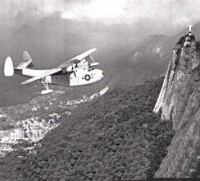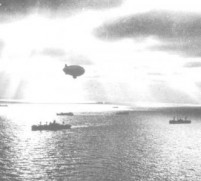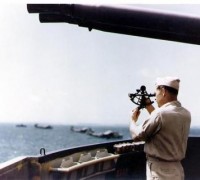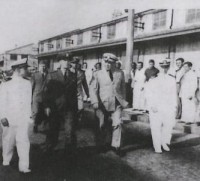- COMMANDER SOUTH ATLANTIC
27)THE BLIMPS ARRIVE
Earlier in this narrative there has been mention of preparations for the introduction of Lighter-than-Air Squadrons into Brazil. Blimps have several advantages for patrol purposes. They can stay in the air longer than planes; sometimes up to 22 hours. The slow speed they are able to maintain permits them to hover over an object, in order to observe it fully. Visibility from a blimp is excellent, for no part of the ship stands in the observer's way. The radar platform is good.
Since the composition of an airship crew is less generally known than that of a plane, some details are worth mentioning here. Three officers normally fly with a blimp, though sometimes the number is four. Six enlisted men round out the regular complement. Together these form a CAC (Combat Air Crew), and it is desirable to keep them together as a unit. The officers are designated Command Pilot, Co-Pilot, and Navigator. Every blimp flyer has the designation "Naval Aviator - Airship". Three CACs should be available for each ship. This does not mean that they are assigned to a given craft, but three to one is considered the proper ratio of crews to ships.
Lighter-than-Air units in the Fourth Fleet operated from the time of their arrival in Brazil under Captain Lyon, Commander Fleet Air Wing Sixteen and head of all air activities. The direct command, however, was held by Captain W. E. Zimmerman. In August 1943, Captain Zimmerman began setting up his organization in Brazil. A month later the ships started moving south. During the remainder of the year and the early part of the next, two Squadrons came and were installed. Squadron 41 (Northern) eventually took care of the entire Brazilian area from Amapa to Fortaleza. Squadron 42 (Southern) patrolled from Fortaleza to Santa Cruz, a little beyond Rio. Each had its own Commander, with a Hedron Squadron based at Recife, the center.
The first airship of the United States Navy to reach Brazil was the K-84, flown from Lakehurst, New Jersey. As an item of interest it might be added that this was the first K Type (non-rigid) Airship to cross the Equator. She arrived in Fortaleza, on September 27, after a flight of 1430 nautical miles and 98 hours spent in the air. Captain Zimmerman, already in Brazil, met the ship and took part in the later stages of the flight.
This first arrival, which belonged to Squadron 41, was based at Fortaleza, as was the second (K-38), which got there on October 13. Fortaleza then became for a time the headquarters of Squadron 41. In the latter part of November, 1943, Squadron 42 moved in and set up at Fortaleza, while its predecessor temporarily vacated and established headquarters farther north. Then, in May, 1943, as a result of new bases being opened in southern Brazil, at Caravelas, Vitoria, and Santa Cruz, Squadron 42 had to spread its ships through the south. Squadron 41 moved back to Fortaleza, but now maintained headquarters at São Luiz, while 42 centered at Maceio.
After both squadrons had become permanently established, the blimp bases in Brazil, in geographical order, were Amapá, Igarape, Assú, São Luiz, Fortaleza, Fernando de Noronha, Ibura, Maceio, Ipitanga, Caravelas, Vitoria, and Santa Cruz. Three of these; Fortaleza, Ibura Field at Recife, and Vitoria, were more theoretical than real; meaning that some facilities for blimps existed at these places but that no ship was ever based at them. From time to time blimps flew to Fernando de Noronha for temporary operations. Ibura had been originally scheduled as a refueling base, and at one time had a mast and mooring circle, but no ship ever landed there. Vitoria became a fueling base solely, and it was never planned to use it for anything else.
The first blimp to visit southern Brazil was the K-84, which went to Santa Cruz for an interim overhauling as early as November, 1943. While there she did some flying over Rio, for publicity purposes and to provide a little show for the populace. She was photographed many times and attracted widespread interest.
The first operational mission in Brazil undertaken by blimps was the escort of a Trinidad-Rio Convoy, southbound, on October 2, 1943. Fro then until the end of the following May, lighter-than-air ships escorted 4862 surface vessels and 2223 surface escorts. The unbelievable size of these figures is due to the fact that each ship is a convoy or escort was counted several times. For instance, a given convoy might be covered by four airships, successively, during its coasting of Brazil. Yet each blimp counted as a separate mission, hence the total number of vessels in the convoy and escort would be added in again whenever a new airship took over.
The lighter-than-air ships could be, and were, put to uses other than covering convoys. Rescue work in the cases of plane crews forced down in North Brazilian jungles revealed the blimps at their best. No other type of craft would have been adequate. Just before Christmas of 1943, an Army Transport Plane had to land a few miles from Amapá, in the jungle. The K-106, piloted by Lieutenant R. A. Powers, went to the rescue. The Army personnel saw the blimp hovering overhead an hour before midnight. It dropped them some food and promised to return at dawn. When the K-106 came back, it made four separate landings, removing 2100 pounds of mail and baggage, plus the plane crew and most members of the landing party, who had hiked in to lend assistance.
Another case occurred on February 4. K-114, at Igarape Assú, received word to proceed to the scene of a plane crash 100 miles to the west. Joined by the K-90, also at Igarape Assú, the blimp started. They found the plane buried in a swamp, but no survivors. They learned that the officers from the wrecked plane had set out for the coast. K-114 continued the search and finally located one of them, Flight Officer J. G. Doherty of the Royal Canadian Air Force. The blimp selected a fairly open field, where cows were observed grazing and slogging about in the swamps. The pilot landed and picked up Doherty, and a little later found his companion, Flight Officer F. B. Clarke, also RCAF. They directed him to the same field ad there descended and took him aboard. No plane could possibly have landed on this spot.
The most spectacular blimp rescue occurred on February 11, when two Army planes came down i a dense jungle clearing. They called K-106, from Amapá, to their aid by use of a life raft radio. This time Lieutenant Powers skillfully maneuvered his ship to the small clearing, and Bos'n J. F. Desmond dropped to the ground and organized a landing party, which chopped away shrubbery and growth with machetes. Lieutenant Powers again brought the ship around. Though he cut some foliage with the propellers, he managed a successful landing. He loaded as many passengers as possible and took off. Meanwhile, the K-11, piloted by Ensign W. T. Raleigh, reached the clearing. Another successful landing was made, more Army personnel loaded, and some Navy men were left behind to lighten weight of takeoff. To conclude this episode, K-106 returned and brought these men away. Usually a blimp landing at a prepared field is made with a party of some 50 men working below on a good runway. When this is considered, the spectacular achievement in the case of these rescues becomes evident.
Another example of the usefulness of airships is that of a PBY, compelled to land on a beach north of Natal. A slow moving blimp dropped gasoline in tanks, which the pilot used to refuel his ship and take off. The number of airships ultimately based in Brazil was 16; each squadron having eight. These were broken down into detachments, consisting of two blimps apiece. Commander C. L. Merts remained constantly in charge of Squadron 42. The Northern Squadron had two skippers; first Lieutenant Commander D. M. Entler, Jr., and later Lieutenant Commander J. J. McLendon. The Hedron Squadron was headed originally by Commander G. D. Zermuehlen, and then by Lieutenant Commander W. H. Spaulding. Captain Zimmerman remained Commander of the Wing throughout the entire period.
Hyper War. Commander South Atlantic Force. U.S Naval Administration in WW II.



